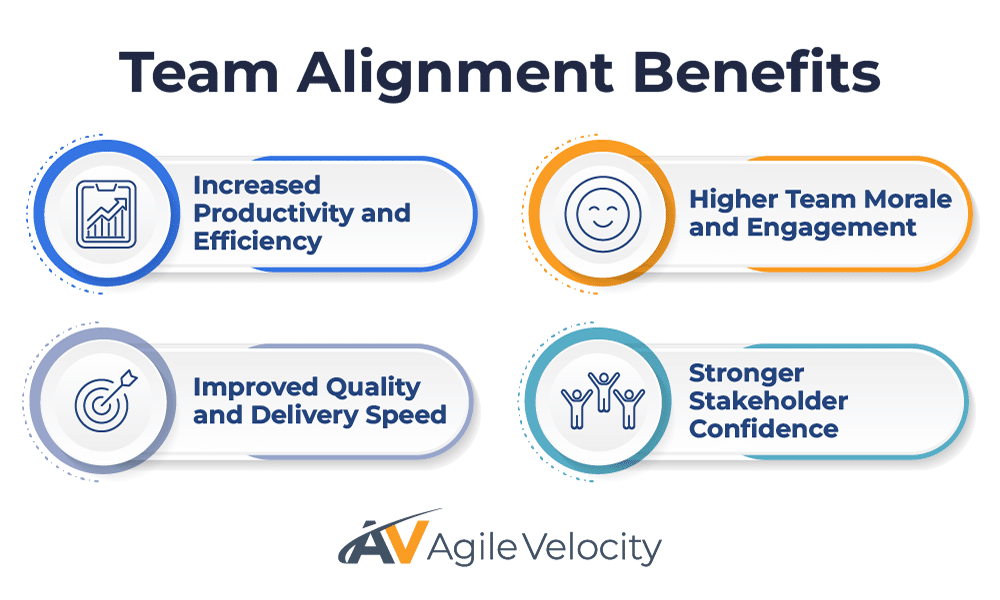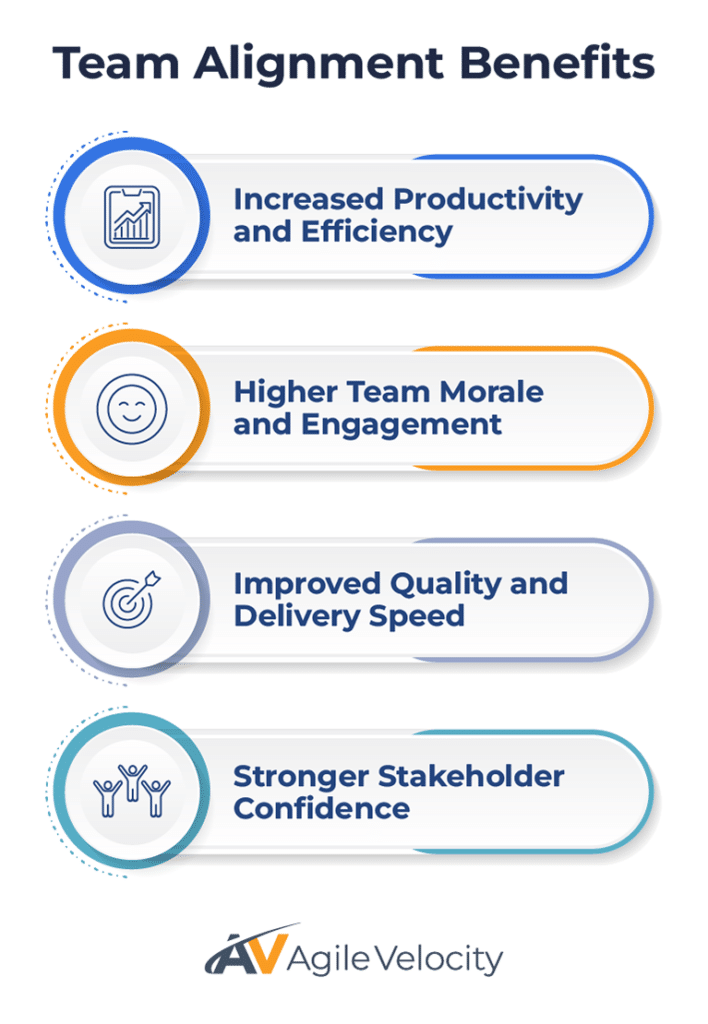Team alignment is crucial for success in environments that prioritize collaboration, adaptability, and quick value delivery. For Agile teams, aligning around a shared goal ensures smooth coordination, reduces misunderstandings, and boosts performance. Aligned teams work together effectively, fostering trust, and driving better results.
This article explores effective methods to achieve team alignment, including improving communication, and optimizing Agile events. Whether you’re a Scrum Master, Product Owner, Agile coach, or team member, these insights will help you create a collaborative atmosphere where everyone moves toward common objectives with clarity and purpose.
From fostering shared goals to enhancing communication, from refining Agile events, to adopting visual tools for tracking progress, we’ll explore actionable ways to build alignment. Additionally, we’ll discuss the role of Agile Coaching and introduce practical strategies teams can use to achieve stronger teamwork and consistent, high-quality results. By the end, you’ll gain steps to help your team achieve better coordination, collaboration, and alignment.
Importance of Team Alignment and Common Goals in Agile Teams
Team alignment goes beyond agreeing on a shared mission—it ensures every team member understands how their contributions connect to broader goals. When everyone is on the same page, Agile teams can collaborate seamlessly, adapt to challenges, and consistently deliver value with fewer obstacles.
Aligning around common goals serves as the foundation for productivity and cohesion. Teams lacking clear alignment often face miscommunication, duplicated efforts, and conflicting priorities. However, when alignment is established, teams enjoy a shared purpose and focus that drive success. Key benefits include:
- Clear Direction: Understanding the “why” behind their work allows team members to prioritize effectively and avoid delays or rework.
- Defined Roles and Responsibilities: Knowing each role and how daily decisions contribute to objectives reduces confusion and overlaps.
- Boosted Morale: Feeling connected to goals and understanding the value of their work fosters trust and motivation.
Alignment acts as a compass, uniting Agile Teams around shared goals that guide their actions, preventing miscommunication and inefficiency.
Effective Communication as the Foundation for Alignment
Effective communication is essential for building team alignment in Agile. Without clear, honest interaction, teams can become misaligned, struggle with misinterpretations, and find it hard to move forward together. Agile teams need a culture of open dialogue where ideas, updates, and feedback flow freely, fostering trust and understanding.
Strategies to Strengthen Communication
- Daily Scrums: Holding brief daily events keeps the team connected. Members share progress updates, highlight blockers, and confirm priorities for the day. Regular alignment on the current work state maintains clarity about roles and ensures no key task is overlooked.
- Establish a Feedback-Positive Culture: Create an environment where input is valued and addressed constructively. Open discussions help resolve misunderstandings before they escalate and ensure all voices are heard.
- Encourage Collaboration Beyond Structured Events: While Agile events like Sprint Planning and Sprint Retrospectives are key touchpoints, casual check-ins and impromptu conversations are equally important. For remote or hybrid teams, informal virtual interactions foster stronger connections and maintain alignment.
Consistent feedback loops and transparent communication prevent minor misalignments from becoming major setbacks. Over time, these habits promote a collaborative culture where every team member feels informed, valued, and empowered to work toward shared goals. For more insights, read Get insights on Agile Coaching.
Agile Events for Better Team Coordination and Alignment

Agile teams rely on structured events to stay coordinated, maintain focus, and align priorities. These events create a regular rhythm, allowing teams to plan, execute, and reflect—key ingredients for operational success. While details may vary by framework, the goal is consistent: uniting the team around clearly defined objectives and fostering continuous improvement.
Sprint Planning: Laying the Foundation for Success
Sprint Planning begins team alignment in Scrum. During this event, the team selects tasks from the Product Backlog for the upcoming Sprint. They set a Sprint Goal and assign responsibilities for each item. This clarity ensures team members leave the session with a shared understanding of priorities, timelines, and roles, minimizing confusion and overlap.
Sprint Retrospectives: Reflecting and Realigning
At the end of a Sprint, Sprint Retrospectives offer a chance to pause, reflect, and realign. Team members discuss what worked, identify areas for improvement, and address challenges that disrupted their flow. Focusing on actionable insights, teams adjust practices and correct misalignments, building a stronger foundation for the next Sprint.
Sprint Reviews: Building Bridges with Stakeholders
Sprint Reviews ensure alignment beyond the core team. These events allow teams to showcase completed work to stakeholders, gather feedback, and confirm that deliverables meet expectations. This open exchange strengthens collaboration with stakeholders and connects team efforts to broader business goals.
Cross-Role Collaboration: Strengthening Team Dynamics
Alignment thrives when Agile roles—Product Owners, Scrum Masters, and the Scrum Team—actively collaborate. Each role brings unique perspectives and responsibilities, from planning to execution. Encouraging open communication ensures well-aligned activities, stronger cohesion, and fewer misunderstandings.
Visual Tools to Improve Transparency and Workflow Clarity
Transparency is fundamental to fostering alignment in Agile teams. When progress is visible and obstacles are clear, everyone—from team members to stakeholders—stays informed and aligned. Visual tools simplify complex workflows, identify bottlenecks, and ensure shared understanding of priorities.
The Kanban Board: A Dynamic Alignment Tool
The Kanban Board is a powerful visual tool for Agile teams, providing a snapshot of the team’s workflow by organizing tasks into stages like “To Do,” “In Progress,” and “Done.” Tasks move between these columns, offering real-time insights into work status and helping the team spot and resolve issues promptly.
Benefits of using a Kanban Board include:
- Preventing Overlooked Tasks: A single source of truth ensures items aren’t lost.
- Highlighting Bottlenecks: Tasks stuck in a column prompt focused problem-solving.
- Encouraging Accountability: Team members can see how their work impacts the entire flow.
Adding Work In Progress (WIP) Limits helps prevent overload and prompt timely collaboration when tasks pile up.
Progress Tracking with Visual Metrics
In addition to the Kanban Board, tools like burndown charts provide data-driven insights into workflow efficiency. Burndown charts show how much work remains versus time left, helping the team track pace against Sprint Goals. By analyzing real-time metrics, teams can adjust approaches and sustain momentum.
These visual aids create a shared understanding, encouraging collaboration and ownership of goals. When everyone sees progress tied to common objectives, alignment becomes a natural outcome.
Leveraging Path to Agility® Navigator for Advanced Team Alignment
Even with robust communication, well-structured Agile events, and effective tools, teams can struggle to stay focused on what truly matters. Path to Agility® Navigator becomes invaluable by helping organizations visualize change. It provides a structured approach for pinpointing needed improvements, aligning on shared goals, and tracking adjustments over time.
Path to Agility Navigator offers aid in uncovering the steps required to achieve desired outcomes. It maps the Agile Transformation journey into actionable milestones, ensuring alignment even in shifting environments. Whether improving communication, refining workflows, or clarifying roles, Path to Agility Navigator delivers the clarity teams need to succeed.
This structured guidance integrates with any framework methodology, giving teams a universal blueprint for continuous improvement.
Request a Demo
Role of Agile Coaching in Driving Team Alignment
Agile Coaching plays a crucial role in bridging knowledge gaps, improving collaboration, and empowering teams to stay aligned. Beyond teaching frameworks like Scrum or Kanban, coaches foster trust, open communication, and continuous improvement—essential pillars for achieving team alignment.
Agile Coaches bring expertise and fresh perspectives, helping teams spot misalignment and guiding them toward resolution. Their role spans people and technical aspects:
- Assessing Team Maturity: Determining where teams are in their Agile journey to identify alignment opportunities.
- Skill Development: Providing practical training for events like Sprint Planning and Sprint Retrospectives.
- Promoting Accountability: Encouraging teams to honor commitments, reinforcing a shared purpose and ownership of goals.
Encouraging Self-Organizing Teams
Agile Coaches nurture self-organizing teams. They guide individuals to collaborate, solve problems, and make decisions independently while staying connected to team objectives. Coaches help with:
- Strengthening Collaboration: Facilitating open communication and shared priorities.
- Navigating Conflict: Redirecting disagreements toward constructive conversations and common goals.
- Adapting Continuously: Reinforcing the importance of iterative learning and alignment in evolving conditions.
By embedding these practices, coaches build lasting alignment habits within teams.
Creating a Culture of Alignment
A culture of alignment arises when coaches encourage transparency and cooperation in daily interactions. This fosters long-term resilience and adaptability, ensuring alignment is maintained—not just achieved during specific sessions.
With effective Agile Coaching, teams align around shared objectives, adapt to unexpected changes, and collaborate more effectively.
Overcoming Common Alignment Challenges in Agile Teams
Even when communication, tools, and objectives are clear, alignment can falter due to remote or hybrid setups, departmental silos, or team conflicts. Targeted strategies can address these hurdles, ensuring consistent focus on shared goals.
Tackling Remote and Hybrid Work Misalignments
Remote and hybrid work models may reduce face-to-face interactions and casual conversations, making alignment less natural. Intentional connections and structured collaboration keep teams unified.
Ways to maintain alignment:
- Regular Syncs: Schedule consistent sessions to clarify ongoing work, address blockers, and reaffirm priorities.
- Collaborative Digital Tools: Utilize shared boards and real-time platforms to visualize tasks and ensure collective visibility across locations.
- Detailed Documentation: Keep clear records of decisions and priorities for asynchronous reference.
Combining intentional communication and transparent updates prevents misalignment across dispersed teams.
Breaking Down Departmental Silos
Large organizations often face siloed teams focusing on immediate objectives, missing the big picture. This results in duplicated efforts or conflicting priorities. To overcome silos and foster alignment:
- Cross-Department Collaboration: Encourage regular sessions where teams share progress, highlighting how their work converges.
- Lean Portfolio Management: Map initiatives against strategic goals to reveal dependencies and ensure alignment.
- Leadership Support: Leaders can unify diverse teams by articulating overarching objectives and inspiring a shared sense of purpose.
Connecting teams around common outcomes amplifies alignment and prevents fragmentation.
Resolving Team Conflicts
When conflicts arise, they can disrupt alignment if team members prioritize personal concerns over the group’s goals. A proactive approach maintains focus:
- Focus on Shared Goals: Shift discussions to the broader objectives, ensuring personal differences don’t derail alignment.
- Facilitate Safe Dialogues: Provide a respectful space for team members to share perspectives, leading to constructive resolutions.
- Encourage Accountability: Hold all parties responsible for both the conflict and its resolution, promoting fairness and collaboration.
Addressing conflicts openly helps teams emerge stronger, with renewed clarity around shared goals. Agile teams often face shifting needs or priorities. Embedding open communication, cross-functional collaboration, and conflict resolution into everyday practices ensures flexibility while preserving alignment when facing the unexpected.
Avoid Unnecessary Setbacks
Practical Strategies for Strengthening Team Alignment and Achieving Goals
Achieving alignment requires consistent effort to keep everyone focused on the same objectives. The following approaches help Agile teams stay unified:
Define and Communicate a Shared Vision
Clarity begins with a well-articulated vision. Explain why the team’s work matters—whether improving user experience, innovating products, or contributing to larger company targets. Show how individual tasks connect to the overall mission, so alignment emerges naturally.
Set Clear Goals Regularly
During events like Sprint Planning, define actionable goals and discuss how backlog items support these objectives. Ensuring clarity on what success looks like for each Sprint Goal keeps work directed and priorities consistent.
Encourage Transparency and Cross-Functional Collaboration
A transparent environment reduces misunderstandings, especially in teams with diverse roles. Promote open communication around responsibilities. If decisions affect multiple functions, communicate them promptly. Tools such as a Kanban Board give everyone insight into workflows, further boosting alignment.
Build Consensus While Valuing Diverse Perspectives
Diverse viewpoints enrich the product but can create friction. Involve team members in key decisions, balancing their expertise with the shared objective. Reaching consensus while acknowledging differences strengthens alignment and respect.
Foster Accountability and Ownership
Teams align most effectively when individuals feel responsible for group success. Emphasize Sprint Goals and communal achievements over individual performance. Methods like pair programming or collective problem-solving reinforce shared responsibility for outcomes.
Make Alignment a Daily Habit
Alignment isn’t a one-time win; it’s an ongoing practice. Encourage frequent touchpoints, such as daily events, to refocus on shared priorities. This keeps the team adaptable and continually aligned with the larger mission.
Benefits of Achieving Team Alignment
Achieving team alignment in Agile environments leads to a cohesive approach towards tasks and projects, streamlining efforts and enhancing productivity. Aligned teams can anticipate challenges more effectively and adapt solutions collectively, fostering an agile mindset geared toward rapid and consistent value delivery. Ultimately, this alignment translates into elevated performance levels, driving greater success in achieving both team-driven and organizational goals.
Teams that achieve alignment unlock advantages extending well beyond project completion:


Increased Productivity and Efficiency – Aligned teams avoid redundant work and re-prioritizations. Clear goals and roles help teams respond faster to changes, making the most of resources.
Higher Team Morale and Engagement – Connected goals create a sense of purpose, enabling more supportive and trusting interactions. Motivation and engagement rise when individuals see the tangible impact of their work.
Improved Quality and Delivery Speed – Clear understanding of stakeholder expectations leads to fewer revisions and faster iterative improvements, elevating overall outcomes.
Stronger Stakeholder Confidence – Transparent progress and alignment boost stakeholder trust, creating positive relationships and better collaboration on current and future initiatives.
Team alignment isn’t just about smoother workflows—it’s about cultivating an environment where teams feel empowered, motivated, and focused on delivering outstanding results.
Achieve Alignment with Expert Guidance
Team alignment forms the bedrock of cohesive, adaptive, and high-performing Agile teams. By defining a shared vision, facilitating open communication, and leveraging Agile events, alignment becomes part of daily life. Coupling these practices with powerful tools—such as Path to Agility Navigator for structured progress—keeps teams focused on what truly matters.
To strengthen alignment within your teams, apply the actionable techniques discussed here. Focus on embedding shared goals, open communication, and visual workflows. Agile Coaching can also close gaps, fostering collaboration and adaptability. By making alignment a continuous priority, your team will be better equipped to achieve goals, deliver value, and maintain long-term success.
Discover how Agile Velocity can enhance your team’s alignment and agility. Through expert guidance we help organizations ingrain alignment and embrace adaptability. Contact us today to start shaping a stronger, more collaborative future for your teams—where alignment fuels success, and agility is your competitive advantage.



